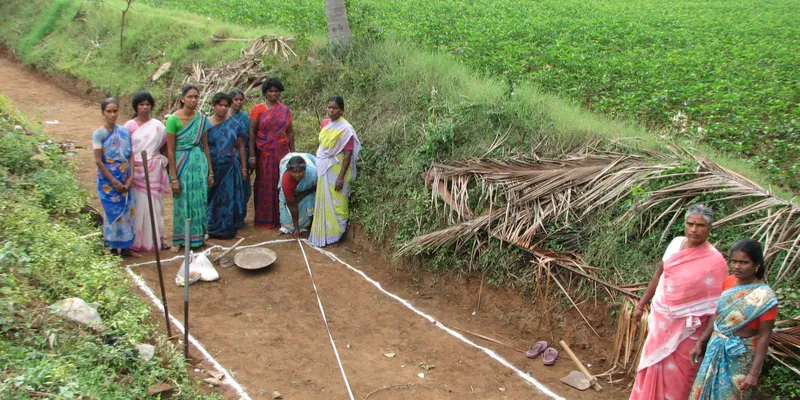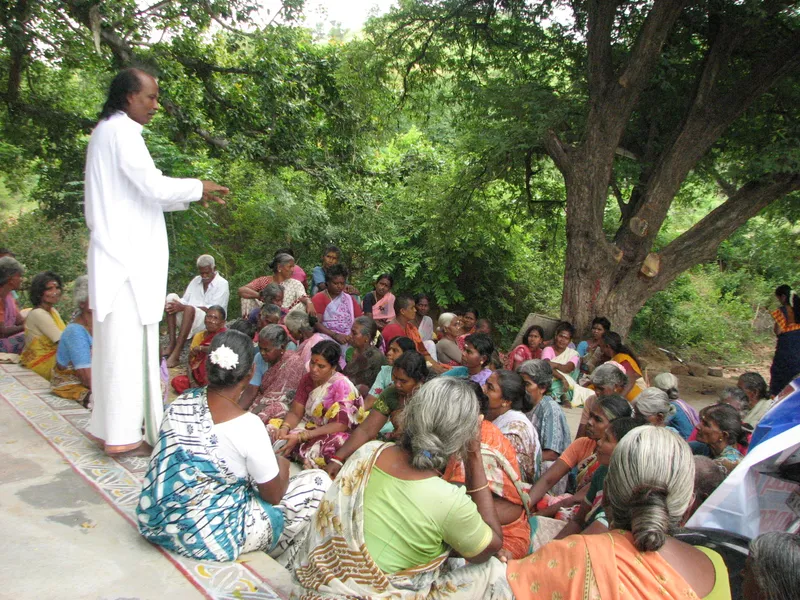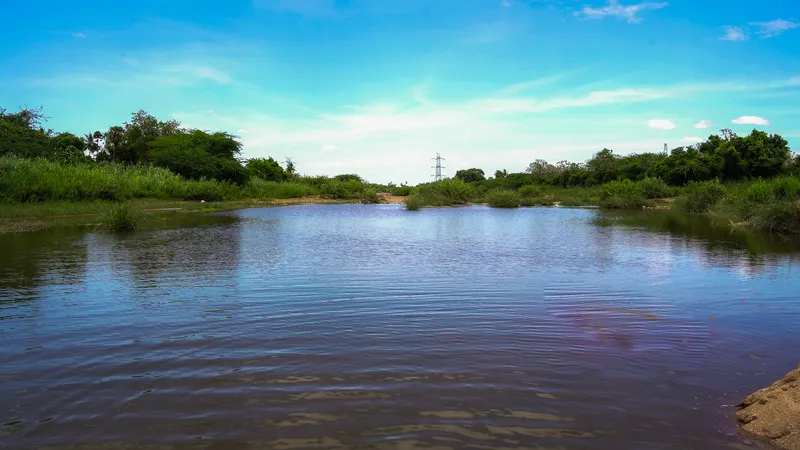How 45,000 women have come together to revive Tamil Nadu’s rivers
Led by Chandrasekar Kuppan from the Art of Living Foundation, the Naganadhi River Rejuvenation Project involved 20,000 women under the TN government’s MNREGA scheme to revive the river through recharge wells and boulder checks. Today, the project is being replicated across 25 rivers in the state.
In February 2005, Chandrasekar Kuppan, who was working as an electrician at the DAV School in Gopalapuram in Chennai, was asked to set up the mic for an Art of Living basic course organised on the school premises.
Intrigued by the instructor’s breathing lessons, he joined in and completed the six-day programme.
“At the end of it, I felt different. I also realised that it had provided me relief from stomach ulcers I had been experiencing for a long time,” he tells SocialStory.

Women working on ground to build recharge wells and check boulders
Little did Kuppan realise that attending this basic programme would lead him to something bigger, and literally, change the course of Tamil Nadu’s rivers. Kuppan left his job in 2009 and became a full-time instructor with the Art of Living.
He also worked with the organisation during the pilot of Jandhan project (a financial inclusion programme by the central government) and travelled all over the state organising Youth Leadership Training Programs (YLTF).
A native of Salamanatham village in Tamil Nadu’s Thiruvannamalai district, Kuppan found that the Naganadhi, a tributary of the Palar river, flowing through Vellore and Thiruvannamali districts, was dry for more than 15 years, even in times of adequate rainfall. This led to migration of people to nearby towns for work.
“I was aware of the organisation’s river rejuvenation projects in Karnataka and Maharashtra. With Guruji’s (Gurudev Sri Sri Ravi Shankar, founder of the Art of Living) blessings, we decided to start with the Naganadhi,” he says.
Feasibility studies by scientists started in 2013 and an action plan was prepared.
“Evaporation of water was the main issue. The construction of roads, buildings, rampant digging for bore wells and chemical farming caused the soil to erode, and retention of water was very difficult,” he explains.
The action plan suggested a simple but practical solution—recharge wells. Recharge or injection wells are subsurface groundwater wells used to directly discharge water into deep water-bearing zones.
Kuppan went to meet the Panchayat president, but he refused to even speak to him. Undeterred, he took the help of Art of Living volunteer fund and managed to install five recharge wells in Salamanatham village. Two months later, when the village received rainfall, the water did not run off like earlier, and a tiny part of the Naganadhi came alive. This time, the panchayat president called to congratulate Kuppan and asked what more could be done.
The river flows

Chandrasekar Kuppan addressing women workers
Kuppan realised that to take the project to scale and involve more villages required funds, and importantly, manpower.
He struck upon the idea of using people enlisted in The Mahatma Gandhi National Rural Employment Guarantee Scheme (MGNREGA) that aims to enhance livelihood security of rural households in the country by providing at least 100 days of guaranteed wage employment in a financial year. Though the scheme is gender-neutral, it prioritises participation of women.
“I approached the Project Director for the Rural Development Agency in Vellore, but he shook his head and countered with, ‘it would be impossible for women to dig wells’. But he took me by surprise by asking if I could teach him and his team yoga,” Kuppan recalls.
He took them through the three-day Happiness Course and at the end of it, the Project Director’s mind had changed. He asked to see pictures of the recharge wells already constructed and asked how the scope of the project could be expanded and the women motivated for work.
“At first, we assembled 20 people, spoke to them about their challenges, took them through sudarshana kriya and capacity building programmes. We worked on addressing their physical, mental, emotional, and communication challenges. We also provided them with valuable information on the need for reviving rivers to leave a better place for our children. And, soon, they were ready to work,” says Kuppan. This number grew as the project scaled over time.
Women in the forefront of reviving rivers

The Naganadhi
A thousand women came together in a spirit of community and built 349 recharge wells and 200 boulder checks across 21 gram panchayats over the course of a year. Boulder checks comprise large, loose boulders that are placed in streams or gullies to slow down water flow and prevent water erosion and increase ground water levels.
In parallel, the women also created four self-help groups (SHGs) to construct the huge cement rings with the help of subsidised loans. Each recharge well takes 23 days to construct.
The hard work of the women paid off, and the groundwater levels rose and it would later run into the Naganadhi.
The news of the revival spread and the project gathered steam. Over the next three years, 20,000 women under the MNREGA scheme built 3,800 recharge wells and over 1,000 boulder checks in Vellore district alone.
The result? The Naganadhi flows throughout the year and has changed the socio-economic landscape of the region and revived agriculture in the region. Prime Minister Narendra Modi also lauded the project on his radio show, Mann Ki Baat.
The project came to be known as The Naganadhi River Rejuvenation Project and is being replicated across 25 rivers in Tamil Nadu in 15 districts, and has so far constructed over 7,000 structures. These include the Saraswathy river, Upper Palar, Mattur, Pambar, Nallar, Bhawani, and others.
“The number of women has risen to 45,000 and their lives have changed for the better. Earlier, they could clock in only 40 days of work under the scheme, they now get more than 80 days, besides additional income from the self-help groups and farming. Migration to nearby towns has also decreased,” he adds.
Shanthi, from Salamanthanam, one of the women in the project, says it enabled consistent earnings under the MGNREGA scheme. “After this project came to our village, not only do we have sufficient water, but we are also earning well. Our people and our farmers are very happy.” Under the scheme, the women earn Rs 292 per day.
The Tamil Nadu government has asked the rural development director to replicate the model in all 35 districts.
“We are preparing an action plan and are partnering with 5-6 NGOs to scale this to other districts. I believe many stakeholders should come together to make this successful,” Kuppan says.
On September 22, which is World Rivers Day, 1,295 women who were part of the project were felicitated on the banks of the Naganadhi by the Art of Living, agricultural organisations, and the people of Vallam Panchayat.
Kuppan’s work is far from complete.
“We have impressed upon the people to take pride in ‘namma oor, namma neer’ (our land, our water). There are more rivers to revive and more people to change,” he says.
Edited by Megha Reddy






